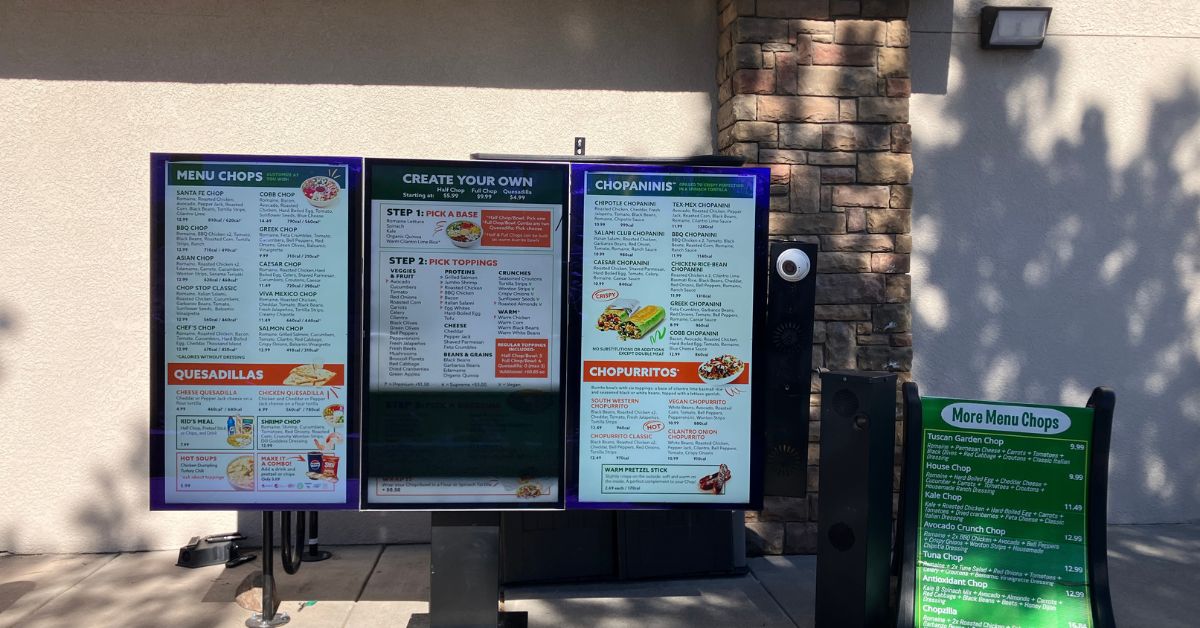The promise of self-service kiosks reducing operating costs while increasing sales sounds almost too good to be true. However, when properly deployed and strategically implemented, these systems deliver measurable results that transform restaurant economics. National IT Pros has deployed hundreds of kiosks across fast food chains, giving us real-world data that proves self-service technology can significantly impact your bottom line—but only when implemented correctly with proper planning and ongoing support.
1. What Can a Self-Service Kiosk Do?
Modern self-service kiosks function as sophisticated ordering platforms that handle far more than basic menu selection. These systems guide customers through complete ordering processes, from menu browsing and customization to payment processing and receipt printing. Advanced kiosks feature high-resolution displays, intuitive touch interfaces, and multilingual capabilities that accommodate diverse customer bases.
Interactive menu displays showcase items with appealing photography and detailed descriptions that encourage upselling and cross-selling. Customers can customize orders extensively, selecting specific ingredients, portion sizes, and preparation preferences without time pressure from waiting lines. This self-paced ordering process often results in more thorough menu exploration and higher-value purchases.
Payment processing capabilities include credit cards, mobile payments, loyalty program integration, and promotional code redemption. Modern kiosks accept contactless payments, mobile wallets, and emerging payment technologies that younger customers prefer. This payment flexibility reduces transaction friction and accommodates changing consumer preferences without requiring additional staff training.
2. Increased Average Ticket Value and Order Accuracy
Self-service kiosks consistently demonstrate their ability to increase average order values through strategic upselling and cross-selling prompts. Digital interfaces can suggest complementary items, promote limited-time offers, and highlight high-margin products at optimal moments during the ordering process. Studies show that kiosk orders typically generate 15-25% higher average tickets compared to traditional counter orders.
Order accuracy improvements represent another significant benefit that directly impacts operational costs. Digital ordering eliminates miscommunication between customers and staff, reducing order errors that result in food waste, customer complaints, and remake costs. Kiosks ensure order details are captured exactly as customers intend, minimizing costly mistakes that damage customer satisfaction.
Customization capabilities allow customers to specify exact preferences, dietary restrictions, and special requests through detailed menu options. This precision reduces order modifications, special instructions, and preparation errors that slow kitchen operations. The result is improved customer satisfaction and reduced food waste from incorrect orders.
3. Optimized Staffing and Operational Efficiency
Self-service kiosks enable restaurants to redeploy staff from order-taking to food preparation, customer service, and dining room maintenance. This reallocation improves overall operational efficiency while maintaining service quality. Staff can focus on food quality, cleanliness, and customer experience rather than repetitive order entry tasks.
Labor cost reductions become particularly significant during peak hours when multiple kiosks can handle high order volumes without requiring additional cashiers. A single staff member can monitor multiple kiosks while assisting customers who need help, maximizing labor efficiency. This staffing optimization is especially valuable given the rising minimum wage requirements and difficulty recruiting reliable front-of-house staff.
Queue management improvements reduce customer waiting times and improve satisfaction. Multiple kiosks can process orders simultaneously, eliminating bottlenecks that occur with traditional single-file ordering lines. Customers appreciate the ability to order at their own pace without feeling rushed or pressured by waiting customers behind them.
4. Installation Costs vs. Return on Investment
Self-service kiosk installations require significant upfront investment, typically ranging from $3,000 to $10,000 per unit depending on features and customization requirements. However, return on investment calculations must consider multiple revenue streams including increased average tickets, reduced labor costs, and improved operational efficiency.
Labor savings alone often justify kiosk investments within 12-18 months. A single kiosk can replace one full-time cashier position, generating annual savings of $25,000-$35,000 in wages and benefits. When combined with increased average ticket values, many restaurants achieve complete ROI within the first year of operation.
Operational cost reductions extend beyond direct labor savings. Reduced order errors minimize food waste, remake costs, and customer complaint handling. Improved order accuracy and faster service increase customer satisfaction and repeat business. These indirect benefits compound over time, creating long-term value that exceeds initial installation costs.
5. Why Partner with National IT Pros?
Successful kiosk deployment requires expertise in hardware selection, software integration, and ongoing support services. National IT Pros brings extensive experience from hundreds of installations across diverse restaurant concepts. We understand the unique challenges different restaurant formats face and can recommend optimal solutions for your specific operational needs.
Our comprehensive implementation process includes site assessment, workflow analysis, and staff training programs. We ensure kiosks integrate seamlessly with existing POS systems, kitchen display systems, and payment processing platforms. Our team handles all technical aspects of installation, testing, and optimization to ensure smooth operation from day one.
Ongoing support services include software updates, hardware maintenance, and performance monitoring. We provide 24/7 technical support that minimizes downtime and protects your investment. Our maintenance programs include regular cleaning, calibration, and component replacement to ensure continued reliable operation.
Proven Results with Professional Implementation
Self-service kiosks deliver real cost savings and revenue increases when properly implemented and supported. The technology has matured beyond experimental status to become a proven operational tool that successful restaurants rely on for competitive advantage.
Want to see actual numbers showing how much your restaurant can save and gain with self-service kiosks? National IT Pros provides detailed ROI analysis based on your specific operation, showing real projected savings and revenue increases. Contact us today for a consultation that reveals the true financial impact of self-service technology on your business.



